How to Use Sora AI: A Complete Guide to Creating Stunning AI Videos
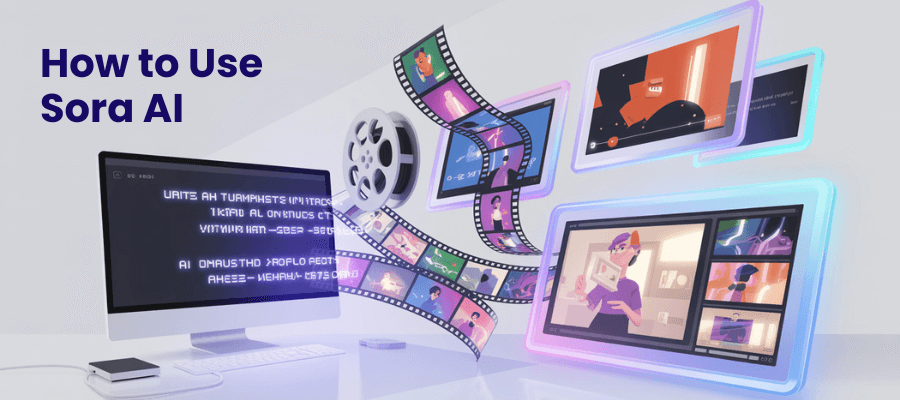
Table of Contents
Have you ever imagined turning your ideas into stunning videos in minutes, without needing to touch a camera or hire a production team? With Sora AI, this is no longer just a dream. This cutting-edge AI video generation tool, developed by OpenAI, can transform simple text prompts into cinematic-quality videos. From marketing campaigns to educational content, Sora AI allows creators to bring their imagination to life in a way that was once possible only in high-end studios.
Unlike traditional video-making tools, Sora AI does not require technical expertise. You do not need to worry about lighting setups, expensive cameras, or complex software. With a few simple inputs, you can generate visually impressive videos that feel natural and engaging.
Key Takeaways
- Sora AI transforms text into cinematic videos: It allows creators to generate realistic, high-quality videos quickly without traditional filming equipment.
- Effective prompts are crucial: The more detailed your descriptions of subjects, environments, emotions, and camera angles, the more accurate and polished the output will be.
- Wide range of applications: Sora AI is used across marketing, filmmaking, education, gaming, real estate, and product visualization to tell stories and showcase ideas.
- Accessible yet evolving platform: While some features may be invite-only and rendering times can be long, OpenAI continues to improve usability, speed, and creative control.
- Ethical and copyright awareness is essential: Creators should ensure originality, avoid misleading content, and comply with OpenAI’s content policies.
- Future potential is promising: Upcoming features like advanced editing, real-time rendering, broader access, and integration with other OpenAI tools will expand creative possibilities.
Table of Contents
What is Sora AI?
Sora AI is an advanced artificial intelligence platform designed to revolutionize video creation. Developed by OpenAI, it uses deep learning and diffusion-based modeling to generate highly realistic videos from simple text descriptions. The technology behind Sora AI combines natural language processing with computer vision, allowing the system to interpret your written prompts and produce visually coherent scenes.
Its primary goal is to simplify video production while maintaining a cinematic standard. Unlike traditional methods, Sora AI does not rely on pre-recorded clips or templates. Every video it generates is unique, based on your input.
Sora AI is suitable for a wide range of creators. Marketers can generate promotional videos quickly, educators can create interactive learning content, and storytellers can visualize their narratives in minutes. It is designed to handle both short clips and complex, multi-scene productions.
Additionally, Sora AI continues to evolve with regular updates. New models improve motion realism, lighting, and scene continuity, making the videos more immersive over time. This ongoing development ensures that creators always have access to state-of-the-art AI video technology.
Key Features of Sora AI
Sora AI is packed with features that make it a powerful video creation tool. Each feature is designed to give creators maximum control and flexibility. Here is a detailed look at the major capabilities:
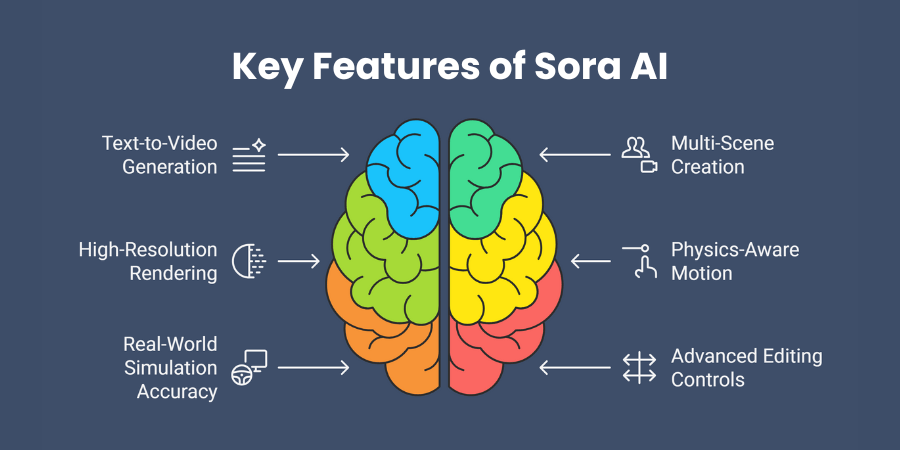
- Text-to-video generation: Sora AI can transform written descriptions into fully animated videos. You simply provide a prompt, and the AI generates visual content that matches your words. For example, if you describe a sunset over a beach with moving waves, the system interprets every element and produces a realistic video scene.
- Multi-scene creation: The platform allows you to design videos with multiple scenes that flow seamlessly. You can create entire storylines or presentations, adjusting each scene individually. This feature is ideal for marketers creating ads or educators designing lesson sequences.
- High-resolution rendering: Videos produced by Sora AI are of high quality, suitable for professional use. You can generate content in full HD or higher, ensuring that your final product is crisp, clear, and visually appealing. High-resolution rendering is essential for projects that require professional output.
- Physics-aware motion: Sora AI simulates real-world physics to make motion appear natural. Objects fall, collide, and move realistically, enhancing the believability of the video. Characters and elements respond to forces and gravity accurately, giving videos a lifelike appearance.
- Real-world simulation accuracy: Environments, lighting, and textures in Sora AI videos are generated to mimic real-world conditions. Shadows fall naturally, reflections are accurate, and environmental elements like water or wind behave realistically. This makes each video more immersive and engaging for viewers.
- Advanced editing controls: Sora AI provides comprehensive tools to fine-tune your videos. You can adjust camera angles, motion speed, scene transitions, lighting intensity, and more. These controls allow creators to maintain artistic direction and produce videos that align precisely with their vision.
How to Access Sora AI
Accessing Sora AI is straightforward, but it depends on your account type and location. Currently, it is available through OpenAI’s platform, either directly or via invitation-only beta programs. Some advanced features may be restricted to early adopters while OpenAI continues to optimize performance.
To get started, you need to create an OpenAI account. Once registered, you can log in to the Sora AI dashboard. Here, you will find all the tools needed to create videos, including text prompt fields, parameter adjustments, and scene management options.
OpenAI provides clear tutorials and tooltips for beginners. You can explore sample projects or start from scratch with your own ideas. The platform is designed to be user-friendly, making it accessible even for those without prior video editing experience.
Being aware of availability is important. Sora AI is gradually expanding access, so signing up early ensures you can explore the latest features. OpenAI also provides updates and community support to help users get the most out of the platform.
How to Use Sora AI: Step-by-Step Guide
Sora AI is a powerful tool, but using it effectively requires understanding its workflow. Follow this structured guide to create professional-quality videos from your text prompts.
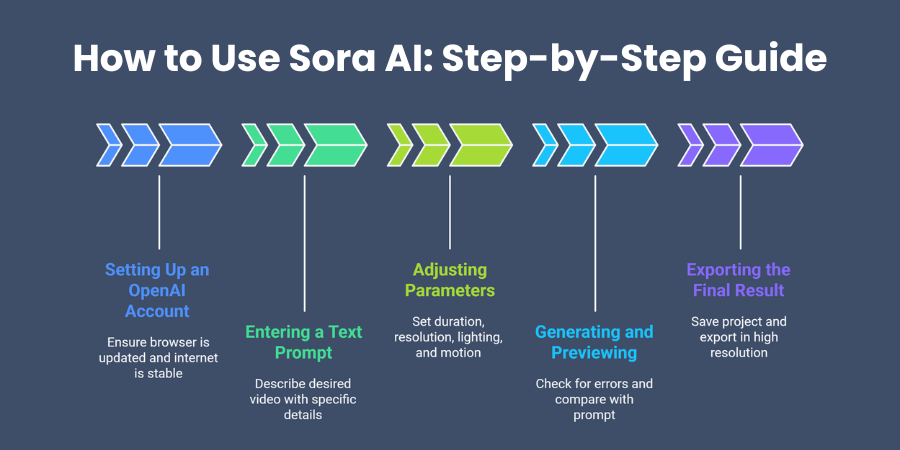
Step 1: Setting Up an OpenAI Account or Accessing Sora’s Dashboard
Before creating your first video, you need access to Sora AI. Begin by visiting the OpenAI website and signing up for an account if you do not already have one. Provide your email, create a secure password, and verify your account through the confirmation email.
Once your account is active, log in and navigate to the Sora AI dashboard. The dashboard is your central hub for all video creation tasks. Here, you can start new projects, manage saved projects, and explore pre-built templates. The interface is designed to be intuitive, making it easy for beginners to navigate and professionals to find advanced options.
Tips for Setup:
- Ensure your browser is updated for best performance.
- Use a stable internet connection to avoid interruptions during video generation.
- Explore sample projects to understand how prompts affect video output.
Step 2: Entering a Text Prompt Describing the Desired Video
After accessing the dashboard, the next step is to write your text prompt. This is the heart of your video creation process. Enter a detailed description of what you want the video to show. Include subjects, environments, actions, emotions, camera angles, lighting, and color tones.
For example, a prompt like: “A young woman walking through a cherry blossom park at sunrise, petals falling around her, captured in a wide-angle shot with soft golden lighting” will give the AI clear instructions to produce a realistic scene.
Tips for Effective Prompts:
- Be specific with objects, characters, and backgrounds.
- Use descriptive adjectives to convey mood and atmosphere.
- Mention any specific camera angles or perspectives.
- Test multiple prompts to see which produces the most accurate results.
Step 3: Adjusting Parameters like Duration, Resolution, Lighting, and Motion
Once the prompt is ready, you can fine-tune your video by adjusting parameters. Sora AI allows you to control video duration, resolution, motion dynamics, lighting, and other elements.
- Duration: Set how long your video should be. Short clips work well for social media, while longer scenes are suitable for presentations.
- Resolution: Choose the quality, such as full HD or 4K, depending on your project needs. Higher resolution ensures a crisp, professional output.
- Lighting: Adjust brightness, shadows, or color temperature to enhance realism and set the mood.
- Motion: Control object and character movements, including speed, smoothness, and physics interactions.
Pro Tips:
- Start with default settings if you are new, then gradually explore advanced options.
- Use consistent lighting and motion settings to maintain realism across multi-scene videos.
Step 4: Generating and Previewing the Video Output
After entering your prompt and adjusting parameters, click the generate button. Sora AI will process your input and create the video. Processing times may vary depending on resolution, length, and complexity of the scenes.
Once the video is generated, preview it in the dashboard. Look for any inconsistencies in motion, lighting, or scene composition. Sora AI also allows you to re-generate or edit specific scenes without starting over, saving time and effort.
Tips for Previewing:
- Check each scene carefully for errors or unrealistic motion.
- Compare the video with your original prompt to ensure accuracy.
- Make minor adjustments to prompts or parameters if needed for better results.
Step 5: Exporting or Downloading the Final Result
When satisfied with your video, it is time to export it. Choose the desired format and resolution. Sora AI supports standard formats like MP4, making it easy to share or upload videos online.
Download the video to your device, or directly share it to platforms like YouTube, social media, or cloud storage. Ensure that file size and resolution match the requirements of your intended use.
Best Practices for Exporting:
- Save a copy of the project on the Sora AI dashboard for future edits.
- Export in the highest resolution if planning to use the video in presentations or marketing campaigns.
- Keep a backup copy in a separate storage location to avoid data loss.
Best Prompts to Use with Sora AI
Creating a great video with Sora AI starts with crafting an effective text prompt. The more precise and descriptive your prompt, the better the AI can interpret your vision. Think of your prompt as a blueprint for the video. The clearer your instructions, the more realistic and polished the output will be.
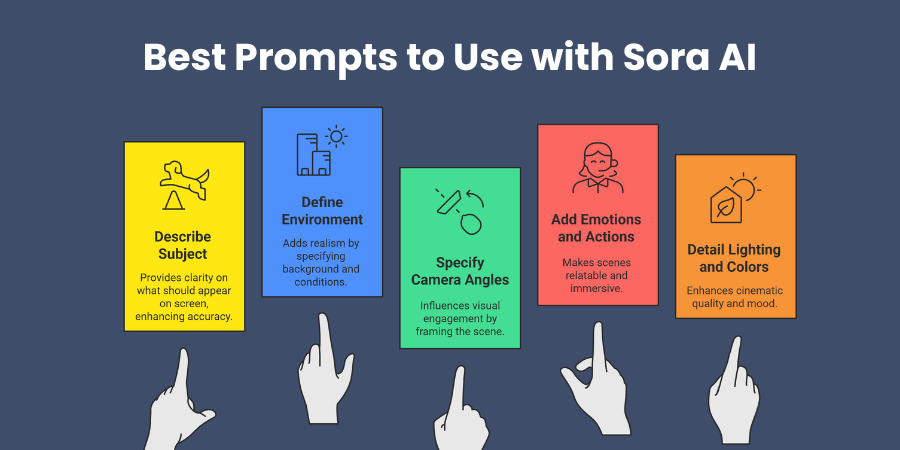
Here are some key elements to consider when writing prompts for Sora AI:
Describing the Subject:
Start by specifying the main subject of your video. Be clear about what or who should appear on screen. For example, instead of writing “a dog in a park,” you can write “a golden retriever playing fetch on green grass under a sunny sky.” Adding details about the subject’s appearance, size, clothing, or expression helps Sora AI generate more accurate visuals.
Defining the Environment:
The setting or environment is crucial for realism. Describe the background, time of day, and weather conditions. For instance, instead of “city street,” you might write “a bustling city street at sunset with glowing neon signs and light rain reflecting on the pavement.” Including such details helps the AI simulate lighting, shadows, and reflections effectively.
Specifying Camera Angles:
Camera perspective can dramatically change the feel of a video. Indicate angles like close-up, wide shot, aerial view, or tracking shot. For example, “a close-up of a chef slicing vegetables with a shallow depth of field focusing on the knife.” This guides Sora AI in framing the scene properly and making it visually engaging.
Adding Emotions and Actions:
If your video involves characters, specify their emotions and actions. Describe facial expressions, gestures, or interactions. For instance, “a young woman smiling warmly while offering a cup of coffee to a friend.” Including emotions makes the scenes more relatable and immersive.
Lighting and Color Details:
Lighting is essential for cinematic quality. Mention the type of lighting and its effect, such as “soft morning light streaming through a window” or “dramatic spotlight on a dancer in a dark studio.” You can also suggest color tones to create mood, like warm golden hues for a cozy scene or cool blue tones for a mysterious atmosphere.
Combining Elements:
For the most realistic and polished videos, combine all these details in your prompt. A full example could be: “A young girl wearing a red raincoat jumping in puddles on a cobblestone street at sunset, with reflections of neon signs on the wet ground, captured in a wide-angle shot with soft lighting.” This level of detail allows Sora AI to create highly accurate and visually compelling videos.
Tips for Better Prompts:
- Use clear, descriptive language. Avoid vague terms like “nice scene” or “beautiful view.”
- Include specific adjectives for subjects, environments, and lighting.
- Break down complex scenes into shorter prompts if needed.
- Experiment with different phrasing to see how the AI interprets your instructions.
Use Cases of Sora AI
Sora AI is more than just a tool for creating videos—it is transforming how industries visualize ideas and tell stories. Its ability to turn text into cinematic-quality visuals makes it valuable for businesses, creators, and educators alike. Here are some primary applications of Sora AI across industries:
Marketing and Advertising: Marketing teams use Sora AI to produce high-impact promotional videos quickly. Instead of spending weeks on a traditional video shoot, marketers can generate compelling ads in minutes.
For example, a brand launching a new product can create a cinematic video highlighting features, demonstrating usage, and telling a story—all from a detailed text prompt. By using realistic motion, accurate lighting, and multi-scene sequences, Sora AI allows brands to engage audiences effectively on social media, websites, and email campaigns.
Businesses can also A/B test different versions of their video content quickly. Adjusting scenes, camera angles, or messaging is simple, allowing marketers to optimize campaigns without additional production costs.
Filmmaking and Storytelling: Independent filmmakers and content creators are using Sora AI to visualize scripts and storyboards. The tool helps in creating short films, concept trailers, and animated sequences without needing expensive equipment or large crews.
For instance, a filmmaker can input a scene description like “A stormy night in a deserted town with lightning striking a clock tower” and receive a fully animated video reflecting the intended mood and composition. This enables rapid prototyping and iterative storytelling, saving time and production resources while maintaining cinematic quality.
Education and E-Learning: Educators and e-learning platforms leverage Sora AI to create interactive learning videos. Complex concepts can be visualized, making lessons more engaging and easier to understand.
For example, a biology teacher can generate a video showing cell division or the human circulatory system in motion. Similarly, history lessons can come alive with historical reenactments or animated timelines. Sora AI allows educators to tailor visuals according to curriculum needs, enhancing retention and learning outcomes.
Gaming and Interactive Media: Game developers and interactive media designers use Sora AI to produce cinematic cutscenes, promotional trailers, and in-game sequences. AI-generated videos help visualize environments, characters, and gameplay mechanics before actual development, speeding up production and reducing costs.
For example, a developer can create a battle scene in a fantasy game with specific lighting, weather, and character actions, allowing the team to evaluate the scene’s visual impact before implementing it in the game engine. This boosts creativity and ensures the final product aligns with the original vision.
Real Estate and Architecture: Real estate agents and architects are using Sora AI to create virtual walkthroughs and promotional content. Detailed property descriptions can be turned into immersive videos, showcasing buildings, interiors, and landscaping.
For instance, an agent can provide a prompt like “a modern three-bedroom apartment with floor-to-ceiling windows, sunlight streaming in, and a rooftop garden view” to generate a video tour. This allows potential buyers to explore properties remotely, saving time and increasing engagement. Architects can also visualize designs, lighting, and materials in a realistic way before construction begins.
Product Visualization and E-Commerce: Businesses in e-commerce and product design use Sora AI to showcase items in realistic environments. Videos can highlight features, demonstrate usage, and create a story around the product.
For example, a fashion brand can generate a video of a model wearing a new clothing line in a street or studio setting. Electronics brands can show how a device functions in daily life. By creating high-quality, visually appealing content quickly, Sora AI helps companies drive engagement, conversions, and brand awareness.
Limitations of Sora AI
While Sora AI is an impressive tool for generating realistic videos from text prompts, it is not without limitations. Understanding these constraints can help users set realistic expectations and use the platform more effectively.
Some limitations are due to the current stage of AI video technology. Others are related to accessibility, performance, and content generation nuances. Being aware of these factors ensures that creators plan their projects accordingly and avoid potential challenges.
Here is a summary of the main limitations of Sora AI:
| Limitation | Description | Impact on Users |
| Restricted Public Access | Sora AI is not fully open to all users yet. Some features may require invitations or beta access. | New users may face delays in accessing the platform or certain advanced features. |
| Rendering Time | Generating high-resolution or multi-scene videos can take several minutes or longer. | Projects requiring fast turnaround may be limited by processing times. |
| Lack of Interactivity | Sora AI currently generates pre-rendered videos without real-time interactivity. | Users cannot create interactive or live-action experiences directly within the platform. |
| Potential Content Biases | AI models may unintentionally reflect biases present in the training data. | Certain prompts may produce inaccurate or culturally insensitive results, requiring careful review and editing. |
| Complex Scene Limitations | Extremely intricate scenes with many moving elements may not render perfectly. | Users may need to simplify prompts or split scenes into smaller segments for best results. |
| Limited Customization for Characters | While AI-generated characters are realistic, fine-grained customization (e.g., facial features, exact gestures) is limited. | Professional creators requiring precise character control may need additional editing tools outside Sora AI. |
Ethical and Copyright Considerations
As powerful as Sora AI is, responsible usage is essential. Generating videos with AI comes with ethical and legal responsibilities. Creators must ensure that their content is original, accurate, and compliant with copyright laws.
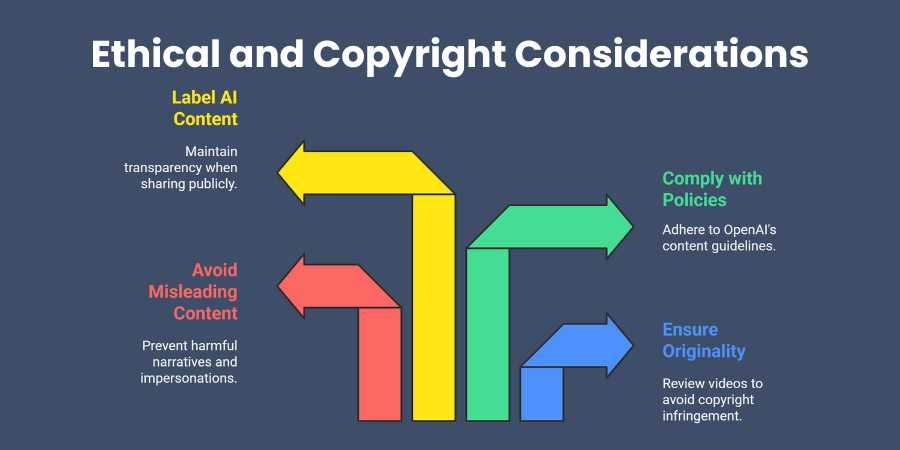
One key consideration is originality. Sora AI produces videos based on patterns learned from vast datasets. While the output is generated by AI, creators should avoid replicating content that closely mimics existing copyrighted work. Always review the video for originality before publishing.
Avoid generating misleading or harmful content. Misuse of AI-generated videos to spread false information, manipulate viewers, or impersonate individuals can have serious consequences. Users should maintain transparency and clearly indicate when content is AI-generated.
Compliance with OpenAI’s content policies is another critical factor. OpenAI enforces guidelines to prevent illegal, harmful, or inappropriate content. Users should familiarize themselves with these policies and ensure their projects adhere to ethical standards.
Best Practices for Ethical Usage:
- Review generated videos to ensure they do not unintentionally copy copyrighted material.
- Clearly label AI-generated content when sharing publicly.
- Avoid prompts that could produce misleading or harmful narratives.
- Follow OpenAI’s content and usage policies strictly.
- Use AI responsibly for educational, marketing, or entertainment purposes without deceiving audiences.
Future of Sora AI
The future of Sora AI is full of exciting possibilities. As AI video technology evolves, we can expect more advanced features, improved accessibility, and greater creative control. OpenAI is continuously refining its models, which suggests that the platform will become even more powerful and versatile over time.
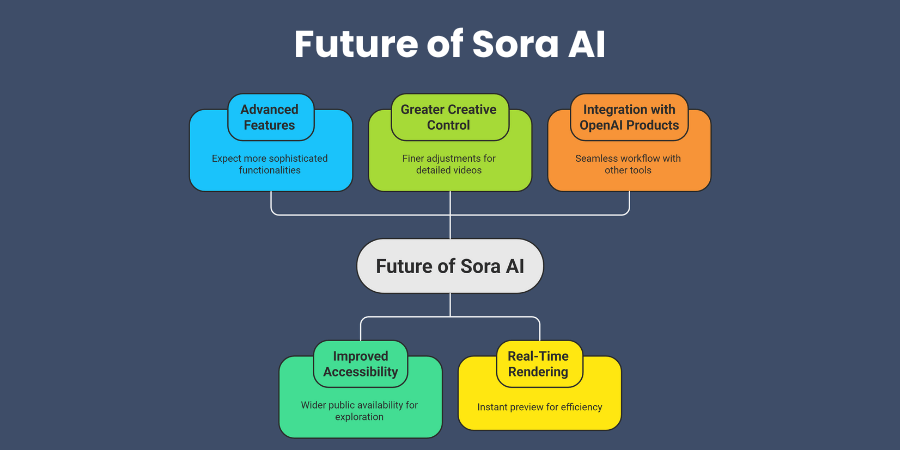
One major area of growth is expanded access. Currently, some features are invite-only or limited to beta users. In the future, wider public availability will allow more creators, businesses, and educators to explore AI-generated video production without restrictions. Advanced editing tools are also expected. While Sora AI already allows parameter adjustments, future updates may provide finer control over elements such as character design, motion dynamics, and scene composition. This will enable users to create highly detailed and precise videos without external software.
Another anticipated improvement is real-time rendering. Currently, generating high-resolution videos can take several minutes or longer. Real-time or near-instant rendering will make it possible to preview complex scenes instantly, boosting efficiency for creators working on tight deadlines. Integration with other OpenAI products is another exciting prospect. Combining Sora AI with tools like ChatGPT or Codex could allow users to generate scripts, storyboards, and interactive content seamlessly within a single ecosystem. This could redefine how storytelling, marketing, education, and entertainment content are created.
Conclusion
Sora AI is rapidly emerging as a revolutionary tool in AI video generation. It empowers creators, businesses, and educators to transform simple text prompts into realistic, cinematic-quality videos. While the technology is still evolving, understanding its features, crafting effective prompts, and following best practices can help users maximize its potential.
From marketing campaigns and educational content to filmmaking and product visualization, Sora AI provides a faster, more accessible, and cost-effective alternative to traditional video production. By experimenting with its capabilities and staying aware of ethical considerations, users can fully harness the creative power of AI. As the platform continues to improve, with more advanced editing tools, faster rendering, and broader access, Sora AI is poised to become an indispensable tool for storytelling, content creation, and digital innovation.
FAQs
What is Sora AI used for?
Sora AI is used to generate realistic videos from text prompts. It is widely applied in marketing, filmmaking, education, gaming, real estate, and product visualization.
How do I create a video with Sora AI?
You start by signing up for an OpenAI account, entering a detailed text prompt, adjusting parameters like resolution and motion, generating the video, and exporting the final result.
Can Sora AI create interactive videos?
Currently, Sora AI generates pre-rendered videos and does not support real-time interactivity. Users can, however, simulate complex scenes and multi-scene narratives.
Is Sora AI free to use?
Sora AI access may vary. Some features are available publicly, while advanced tools or beta access may require an invitation or subscription.
How can I ensure my Sora AI videos are original and ethical?
Use unique prompts, avoid copying copyrighted content, label AI-generated videos clearly, and follow OpenAI’s content guidelines to maintain ethical standards.
Shaif Azad
Related Post
Top 10 AI Development Companies in New Jersey for Business
Are you searching for the perfect AI development partner in New Jersey? Have you wondered which...
Top 10 AI Development Companies in New Hampshire
Are you watching New Hampshire’s tech landscape transform before your eyes? Your state is quietly becoming...
Top AI Companies in Nebraska Every Business Should Know
Are you a Nebraska business owner wondering how artificial intelligence could transform your operations? Picture this...




